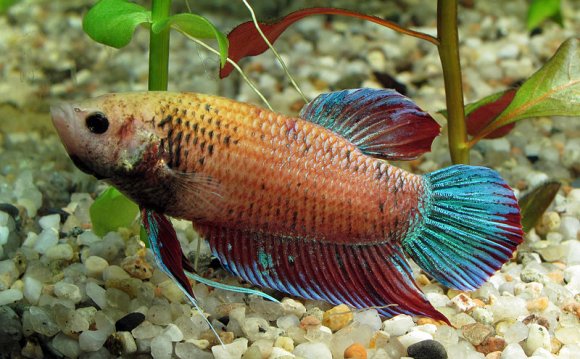
Mouthbrooders actually keep their eggs in their mouths until the eggs hatch. The eggs are again laid a few at a time, and once the male fertilizes them, the parent doing the mouthbrooding gathers them up in his/her mouth. That parent eats sparingly, if at all, until the baby fish are released. Examples of mouthbrooders are male arrowanas and female cichlids.
Marine fish also lay eggs. Some are substrate spawners, but many lay pelagic eggs that float in the plankton. There the eggs hatch into a larval stage, and the larvae float freely and eat tiny plankton until they grow into fish.
``I think my tetras spawned. Where are the eggs?''
Parental care in the fish world varies widely. Parents can be anywhere on a continuum from eating all their eggs or fry, to both parents fiercely guarding their eggs and fry.
Many fish parents show some common behaviors, so I will discuss them here.
Most fish consider any and all fish eggs and young to be a tasty treat. Therefore most fish will not hesitate to snack on any they find, including their own. This means that egg scatters and many substrate spawners really cannot be bred in a community tank, as the eggs will quickly be eaten by the parents and other fish. Marine fish and invertebrates also eat eggs. Livebearers are especially notorious for eating their young.
A few fish ignore their eggs or fry, and so can be bred in a species tank. White cloud minnows can breed this way, and many killifish will at least ignore the eggs. Baby killies are fair game, though. Guppies will also often ignore babies if fed properly.
Other fish have one parent that guards the eggs and fry. Most bubblenest builders and mouthbrooders operate this way, as do some substrate spawners. The responsible male or female stays with the eggs and young, until they are free swimming. With bubblenest builders, the male tends the nest, blows bubbles as they pop, and keeps any falling eggs or fry in it. He will also defend the nest against other fish. Mouthbrooders simply hide their eggs in their mouths, and some substrate spawning catfish will hide the eggs underneath them. Certain substrate spawning cichlids also have one parent care for the eggs and fry.









